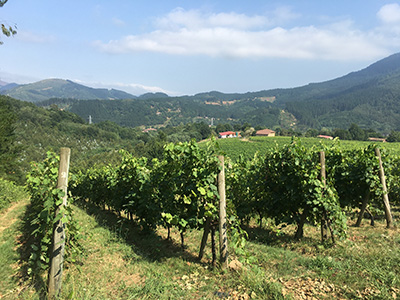
Astobiza is one of the driving forces behind DO Arabako Txakolina, the third txakoli appellation established in the Basque Country. An entrepreneur in the construction sector, Xabier Abando always kept fond memories of vineyards from his childhood. In the 1940s, his father and grandfather grew vines in Artxanda, one of the mountains surrounding the city of Bilbao, and dreamt about making a great wine.
Many years later, Abando found the right place to pursue that dream: Okondo, a small village in the province of Álava, 30 kilometres southeast of Bilbao. After purchasing the Astobiza caserío (the traditional Basque farmhouse) and its surrounding land, the first vines were planted in 1996. The wines were produced in local wine facilities until a winery was built in 2007. Right from the start, Ana Martín, winemaker and consultant with extensive experience in the three txakoli producing areas, has been behind the wines.
Astobiza owns 14 hectares of vineyards in the Ayala valley. Seven are planted around the winery; the rest are located in the nearby villages of Olabezar (3 ha) and Menagarai (4 ha). They also work with purveyors to a total of 30 ha. The Astobiza property produces around 50,000 bottles, whereas purchased grapes result in 40,000 bottles. This is important since Astobiza is integrated in Grandes Pagos de España, an association of single-estate producers whose members can only make wines with grapes sourced from their properties.
There are seven plots on the Astobiza property, covering a hill that stands at an elevation of 280 metres with a maximum gradient of 15%. Framed by pine forests and some eucalyptus trees, this is an isolated spot with distinctive clay-limestone soils and varying proportions of sand. With six hectares under vine, Hondarrabi Zuri is the dominant variety but there are other grapes such as Hondarrabi Zuri Zerratia (Petit Courbu) and Gros Manseng (Izkiriot Handi in Basque). Focused on sustainable farming practices, Astobiza does not use herbicides and treatments are limited to as little as possible. Hand picking is the norm here.
A grape macerator is used in the winery and fermentation takes place in stainless steel vats -inert tanks are seen a key factor to keep the freshness in the wines. As is the case in most txakoli producers, malolactic fermentation is avoided.
Their flagship white is called Astobiza (€10), a blend of Hondarrabi Zuri with 10% of Hondarrabi Zuri Zerratia. Malkoa (€35, 6,500 bottles) is a concentrated single-vineyard Hondarrabi Zuri with distinctive salinity on the finish after ageing for almost two years in egg-shaped concrete tanks. On the pipeline awaits an upgraded version with six extra months in barrel which will be released as Malkoa Colección Privada starting on the 2017 vintage. Finally, Astobiza Vendimia Tardía (€18 the 37.5 cl. bottle) is a late harvest, naturally sweet wine made with Gros Manseng. With 80 to 90 grams of sugar and under 12.5% abv., it is balanced and citrusy, a far cry from the syrupy notes often found on many sweet Spanish wines. It also shows the potential of the region to produce more wines of this style.
Another noteworthy addition is a rosé (6,000 bottles, €12) made with equal amounts of white (Hondarrabi Zuri) and red grapes (the Hondarrabi Beltza is sourced from vineyards outside the estate). After a short maceration, musts from both grapes are fermented together and kept in stainless steel tanks without lees. The wine was originally produced for the US market, but from the 2019 vintage it can also be found in Spain.
Thanks to its bold labels for txakoli standards emphasizing handmade concepts, the wines can be easily spotted on the shelves. In addition, Astobiza has expanded its activity beyond wine. This is partly due to the fact that its restless manager, Jon Zubeldia, who is also Abando's son-in-law, is a former chef who trained at Hotel Lutecia in Paris and Café de Paris in Biarritz, before returning to Spain to work at fine restaurants such as Echaurren (La Rioja), Sergi Arola and Paradores before starting his own restaurant, Zallo, in Cuzcurrita del Río Tirón in La Rioja. Jon has recently launched a gin made mostly with local botanicals as well as a white vermouth that is sold with a small sample bottle of a red version. He is now busy investigating everything there is to know about pepper.
Astobiza wines can be found in over 20 countries, including the United States, Japan, Russia, Scandinavia and other traditional European markets.
Most popular
NEWSLETTER
Join our community of Spanish wine lovers


